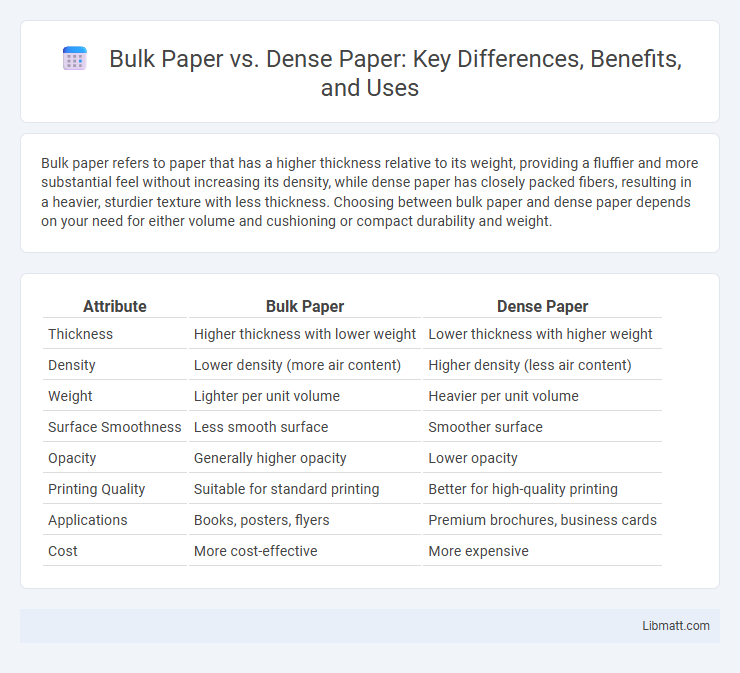Bulk paper refers to paper that has a higher thickness relative to its weight, providing a fluffier and more substantial feel without increasing its density, while dense paper has closely packed fibers, resulting in a heavier, sturdier texture with less thickness. Choosing between bulk paper and dense paper depends on your need for either volume and cushioning or compact durability and weight.
Table of Comparison
| Attribute | Bulk Paper | Dense Paper |
|---|---|---|
| Thickness | Higher thickness with lower weight | Lower thickness with higher weight |
| Density | Lower density (more air content) | Higher density (less air content) |
| Weight | Lighter per unit volume | Heavier per unit volume |
| Surface Smoothness | Less smooth surface | Smoother surface |
| Opacity | Generally higher opacity | Lower opacity |
| Printing Quality | Suitable for standard printing | Better for high-quality printing |
| Applications | Books, posters, flyers | Premium brochures, business cards |
| Cost | More cost-effective | More expensive |
Understanding Bulk Paper vs Dense Paper
Bulk paper refers to sheets with higher thickness relative to their basis weight, providing a cushiony feel and increased stiffness without added weight; dense paper, however, has compact fibers resulting in a thinner, heavier, and more rigid sheet. Understanding the balance between bulk and density helps you select the right paper for printing needs, where bulk paper enhances tactile quality and dense paper improves opacity and durability. Your choice impacts not only the look but also the performance and cost-efficiency of printed materials.
Key Differences Between Bulk and Dense Paper
Bulk paper features increased thickness and lower density, making it ideal for padding and a cushioned feel, whereas dense paper has higher density and a smoother surface suitable for high-quality printing and fine detail. Your choice depends on the application, with bulk paper offering better opacity and printability, while dense paper provides superior rigidity and a premium finish. Understanding these key differences ensures you select the right paper type for optimal performance and aesthetics.
Importance of Paper Density in Printing
Paper density significantly impacts print quality, affecting ink absorption and color vibrancy. Bulk paper, with higher thickness relative to weight, provides better opacity and prevents ink bleed-through, making it ideal for double-sided printing. Choosing the right density ensures Your prints maintain clarity and durability, especially in professional projects requiring sharp visuals.
Pros and Cons of Bulk Paper
Bulk paper offers superior thickness and opacity without increasing weight, making it ideal for packaging, brochures, and high-quality print materials that demand durability and a premium feel. However, bulk paper may be less smooth and less dimensionally stable than dense paper, potentially affecting print clarity and precision. Your choice depends on whether tactile quality and bulkiness outweigh the need for sharp image reproduction and structural stability.
Pros and Cons of Dense Paper
Dense paper offers superior durability and a smoother surface ideal for high-quality printing and writing, ensuring your documents appear sharp and professional. However, its higher weight and thickness can increase shipping costs and reduce flexibility for folding or binding compared to bulk paper. While dense paper excels in longevity and presentation, it may not be the best choice for projects requiring lightweight or highly pliable materials.
Applications Best Suited for Bulk Paper
Bulk paper, characterized by its high thickness relative to basis weight, excels in applications requiring a substantial, tactile feel such as business cards, postcards, and packaging materials. Its lofty structure provides excellent opacity and stiffness, making it ideal for premium brochures and covers that benefit from a durable yet lightweight composition. This type of paper is well-suited for products demanding a combination of volume and strength without increasing weight significantly.
Applications Best Suited for Dense Paper
Dense paper is best suited for applications requiring durability and rigidity, such as packaging, book covers, and artistic prints where a firm surface enhances the final product. Its compact fiber structure provides superior strength and smoothness, making it ideal for high-quality printing and embossing tasks. You will find dense paper advantageous in projects needing both sturdiness and refined texture.
Cost Comparison: Bulk Paper vs Dense Paper
Bulk paper generally costs more per ream than dense paper due to its thicker, airier composition, which requires specialized manufacturing processes and higher-quality raw materials. Dense paper is less expensive because it is more compressed, using less fiber volume and thus reducing production costs. Choosing between bulk and dense paper depends largely on balancing budget constraints with desired paper characteristics such as thickness and tactile quality.
Environmental Impact of Bulk and Dense Paper
Bulk paper typically has a lower environmental impact due to its ability to use less raw material and energy during manufacturing, resulting in reduced carbon emissions and water usage. Dense paper, while offering higher durability and quality, often requires more fibers and chemicals, increasing its environmental footprint. Choosing bulk paper supports sustainable forestry practices and promotes resource efficiency in paper production.
How to Choose the Right Paper Type for Your Needs
Choosing between bulk paper and dense paper depends on your specific printing or writing requirements, considering factors like thickness, weight, and texture. Bulk paper offers greater thickness with less weight, ideal for creating volume without heaviness, while dense paper provides a tighter, smoother feel preferred for high-quality printing and professional documents. Evaluate your project's needs for durability, finish, and appearance to select the paper type that enhances your results and ensures optimal performance.
bulk paper vs dense paper Infographic

 libmatt.com
libmatt.com